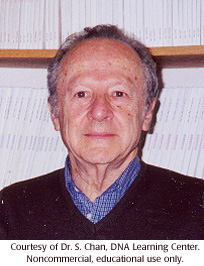Concept 20 A half DNA ladder is a template for copying the whole.


 Matthew Meselson and Franklin Stahl invented the technique of density gradient centrifugation and used this to prove that DNA is replicated semi-conservatively. Arthur Kornberg identified and isolated DNA polymerase I — one of the enzymes that can replicate DNA.
Matthew Meselson and Franklin Stahl invented the technique of density gradient centrifugation and used this to prove that DNA is replicated semi-conservatively. Arthur Kornberg identified and isolated DNA polymerase I — one of the enzymes that can replicate DNA.
Matthew Stanley Meselson (1930-)

Matthew Meselson was born in Denver, Colorado. He had always wanted to be a chemist and had a huge lab workshop set up in his family's basement and garage. Meselson studied chemistry at the University of Chicago and then did his graduate work at the California Institute of Technology with Linus Pauling. Meselson's thesis project was to use X-ray crystallography to figure out the structure of a specific protein.
In 1954, Meselson went to Woods Hole to be a teaching assistant. Here, Meselson met Franklin Stahl — a post-doctoral fellow who was taking courses to learn some molecular biology techniques.
Meselson and Stahl had a profitable summer during which they discussed theory and possible experiments. They were especially interested in trying to devise a way to prove or disprove Watson and Crick's model of semi-conservative replication. Meselson and Stahl found themselves so in tune with each other's ideas that they agreed to work together on devising the right experiment. Stahl got a post-doctoral position in Caltech, and by 1957 the two had the experimental proof for the semi-conservative replication of DNA. They did this by inventing a new technique called density gradient centrifugation, which uses centrifugal force to separate molecules based on their densities. Their "classic" paper was published in 1958 and their experiment has been called "one of the most beautiful experiments in biology."
In 1957, while doing the experiments with Stahl, Meselson gathered enough data to finish his Ph.D. with Pauling. He then stayed at Caltech, first as a research fellow and then as an assistant professor of chemistry. Meselson worked on phage recombination — showing that recombination results from the splicing of DNA molecules. In 1960, François Jacob and Sydney Brenner came to his lab at Caltech where they obtained the data necessary to prove the existence of mRNA.
In the fall of 1960, Meselson accepted the position of associate professor of molecular biology at Harvard University, where he is currently the Thomas Dudley Cabot Professor of the Natural Sciences. He discovered the enzymatic basis of host DNA protection, where the cell recognizes its own DNA by adding methyl groups to it. Foreign DNA will be attacked and destroyed by restriction enzymes but host, methylated, DNA remains intact. Meselson also discovered the process of DNA mismatch repair, which allows cells to fix mistakes in DNA. Currently, Meselson's research interest has to do with the evolution of sexes, and he is using the small invertebrate Rotifera as a model system.
Since 1963, Meselson has been concerned about the use of chemical and biological weapons in warfare. He has acted as a consultant for a number of government agencies, and participated in scientific studies that studied the effects of accidental and misuse of biological weapons. Meselson is the co-director of the Harvard Sussex Program on Chemical Biological Weapons (CBW) Armament and Arms Limitation. This is a program that attempts to set limits on the use of chemical and biological weapons. Meselson is also the co-editor of The CBW Conventions Bulletin.


Matthew Meselson was one of the scientists who investigated the use of biological agents in Vietnam. The U.S. government asked him to analyze the residue left by possible bio weapons. The samples turned out to be bee pollen.

Initially, Meselson and Stahl used phage DNA in their density gradient experiments. Phage DNA did not band well in the centrifuge tubes and gave uninterpretable results. Why might this be so?
 DNA and proteins are key molecules of the cell nucleus.
DNA and proteins are key molecules of the cell nucleus. One gene makes one protein.
One gene makes one protein. A gene is made of DNA.
A gene is made of DNA. Bacteria and viruses have DNA too.
Bacteria and viruses have DNA too. The DNA molecule is shaped like a twisted ladder.
The DNA molecule is shaped like a twisted ladder. A half DNA ladder is a template for copying the whole.
A half DNA ladder is a template for copying the whole. RNA is an intermediary between DNA and protein.
RNA is an intermediary between DNA and protein. DNA words are three letters long.
DNA words are three letters long. A gene is a discrete sequence of DNA nucleotides.
A gene is a discrete sequence of DNA nucleotides. The RNA message is sometimes edited.
The RNA message is sometimes edited. Some viruses store genetic information in RNA.
Some viruses store genetic information in RNA. RNA was the first genetic molecule.
RNA was the first genetic molecule. Mutations are changes in genetic information.
Mutations are changes in genetic information. Some types of mutations are automatically repaired.
Some types of mutations are automatically repaired.